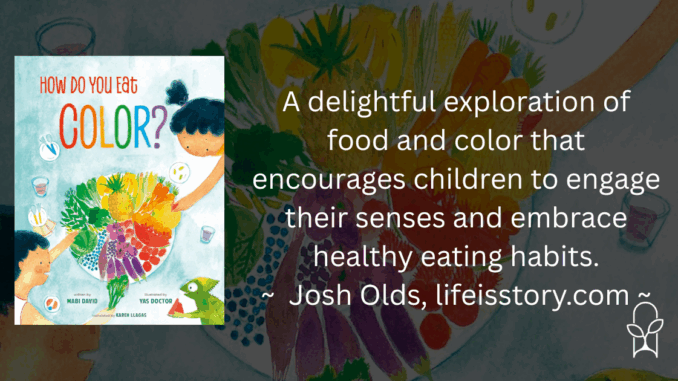
Goodreads
"Truly engaging . . . lyrical and vibrant." — Booklist (STARRED REVIEW)
A day’s journey through a rainbow of fruits and vegetables.
Do you know how red tastes? What about blue, orange, purple, or even white? As a boy, a girl, and their chameleon go through their day, they meet a bounty of colorful fruits and vegetables. They wake up with bright tomatoes and hibiscus, taste sunshine in yellow pineapples and mangoes, yawn with purple yams, and drift off to sleep as the colors darken to black.
Translated from Filipino, this imaginative book features produce harvested from the Philippines and around the world. Whether children love carrots, moringa, dragon fruit, eggplants, or red beans, How Do You Eat Color? offers them dozens of different—and delicious—opportunities to eat something new. Engaging back matter after the story will help readers explore healthy eating and learn ways to incorporate plants into their meals.
As a parent, I’m always trying to introduce my kids to new foods—healthy foods in particular—in order to expand their palette and their knowledge of the natural world. Mabi David’s How Do You Eat Color? does exactly that, using the brilliance of color to go on a vibrant journey through different fruits and vegetables. Following two children and their chameleon companion, David explores how each color tastes, feels, and evokes emotion, transforming everyday foods into a kaleidoscope of experiences. From the bright reds of tomatoes to the deep purples of yams, the book encourages children to engage with food in a playful and imaginative way.
One thing you should note, however, is that How Do You Eat Color? was originally published in the Philippines and is translated from Filipino into English by Karen Llagas. When a book relies on poetic and visual imagery, translation can be difficult—particularly when it comes to translating into child-friendly vocabulary. That is something the book struggles with, but beyond that hurdle, there’s another more practical one: Many of the colorful foods listed aren’t typical western fare. This can be a good thing, because the focus on Southeast Asian produce will introduces readers to diverse foods, promoting curiosity and openness to new experiences. But it can also create difficulty because the tastes and textures the book is trying to evoke will fall flat to readers who haven’t experienced those tastes and textures—and moreover, might not be able to find those fruits in their geographical region!
Yas Doctor’s illustrations are a highlight, with lush, textured visuals that bring the foods to life. The imaginative depictions—such as children paddling on mango slices or resting on yam beds—add a whimsical touch that complements the lyrical text. The artwork not only enhances the sensory experience but also serves as an engaging tool for children to visualize and connect with the foods described.
Overall, How Do You Eat Color? is a delightful exploration of food and color that encourages children to engage their senses and embrace healthy eating habits. It would be especially great for learning about Southeast Asia and maybe go to an Asian market to source the foods listed in the book so you can taste them alongside the characters in the book to see if you agree.
